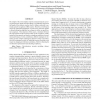Free Online Productivity Tools
i2Speak
i2Symbol
i2OCR
iTex2Img
iWeb2Print
iWeb2Shot
i2Type
iPdf2Split
iPdf2Merge
i2Bopomofo
i2Arabic
i2Style
i2Image
i2PDF
iLatex2Rtf
Sci2ools
ICASSP
2009
IEEE
2009
IEEE
Strategies for modeling reverberant speech in the feature domain
The length of the room impulse response characterizing the acoustic path between speaker and microphone is significantly larger than the length of the analysis window used for feature extraction in automatic speech recognition (ASR) systems. Therefore, reverberation caused by multi-path propagation of sound waves from the speaker to distant-talking microphones has a dispersive effect on speech feature sequences. This dispersive effect causes a mismatch between the input speech and the acoustic models of the recognizer, usually trained on clean speech, and leads to a significant reduction of recognition performance. In this contribution, different strategies for obtaining acoustic models capturing the dispersive effect of reverberation are investigated in terms of modeling accuracy, flexibility with respect to changing reverberation conditions, effort for obtaining the reverberation representation and decoding complexity.
Automatic Speech Recognition | Dispersive Effect | ICASSP 2009 | Reverberation | Signal Processing |
| Added | 17 Aug 2010 |
| Updated | 17 Aug 2010 |
| Type | Conference |
| Year | 2009 |
| Where | ICASSP |
| Authors | Armin Sehr, Walter Kellermann |
Comments (0)

